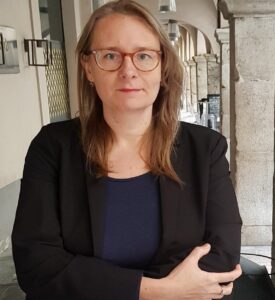Ria Berg is currently Director of the Finnish Institute in Rome and adjunct professor of the University of Helsinki.
She obtained her PhD from the University of Helsinki in 2010, with a thesis on women’s objects in Pompeii. On this theme, she has recently published the volume ‘Il Mundus muliebris a Pompei. Specchi e oggetti da toletta nei contesti domestici’.
Her publications concentrate on Roman objects, domestic space, gender and ethnicity, and more recently on the human-environment relation in ancient cities.

Art, whatever it takes – RomeArtProgram has made interviews with people involved in art, living in Italy, the USA and the UK, to know their feelings during these hard times.
-> Ria Berg Interview:
RomeArtProgram: When and how was your Institution founded?
.
-> Ria Berg: The Foundation Institutum Romanum Finlandiae was established as early as 1938, with the wish to join the other 19 nations that already then had their Academies in Rome. However, it was not until 1950 that a suitable building was found, the Villa Lante on the Gianicolo. It was really a stroke of luck that the Finnish state could acquire this magnificent renaissance villa through the donation of a private Maecenas, the press magnate Amos Anderson, who loved Roman history and felt that Finland should cultivate its classical roots.
.
.
RAP: Are there similar Institutions of yours in other Countries in the world?
.
-> Ria: Finland has a network of 16 institutes in the world capitals. Of these, 13 are cultural institutes that promote Finnish arts and creativity in their position countries. Three – Rome, Athens, and Beirut – are research Institutes that create opportunities for Finnish students and scholars to do their research abroad.
.
.
RAP: What are the main objectives towards which your activity is oriented?
.
-> Ria: Our core mission is to do humanistic research, mainly classical philology, history, archaeology and art history, and to facilitate the work of Finnish scholars in Italy. We also promote Finnish artists, writers and musicians, giving them residencies and organizing concerts, and connecting them with the Italian artistic and academic worlds.
.
.
RAP: Is there a project or event of which you are particularly proud?
.
-> Ria: Important milestones have been the two excavation projects, one on the Forum Romanum, at the fount of Juturna, in the 1980s, and the other at Lake Nemi, in the Villa of Caligula, in collaboration with the other Nordic institutes in Rome, around 2000. As Director, I am proud every time our scholars and artists present their work here in international contexts. The Nordic November has been an important joint enterprise of the Nordic institutes and embassies for two editions already. Seeing Aki Kaurismäki’s movie Fallen Leaves have its premier in Rome in this framework, last November, was a proud and emotional moment.
.
.
RAP: Does the Institution accept fellows? …from which countries?
.
-> Ria: All our fellows are Finns, to whom we want to give the opportunity as students and scholars to work in a facilitated environment, helping them to get access to the libraries, the archives, the museums and the excavations they need for their work. At Villa Lante we have 11 rooms for residents and a studio for an artist. However, last year we have started a small exchange project with the Almo Collegio Borromeo of Pavia, so as to host an Italian student who can collaborate with his or her Finnish peers.
.
.
RAP: Which is the role of Academies and Art schools today?
.
-> Ria: They give space and peace to think, to learn, to get new international perspectives. Our fellows also appreciate greatly the opportunity orf interdisciplinary encounters between artists and researchers, students and emeritus professors, Finns and Italians.
.
.
RAP: In your opinion, how have new technologies changed art today?
.
-> Ria: Our resident artists nowadays work more with photography, video, and installation, collecting notes during their stay and realizing the final work in Finland. The old wooden easels for oil-colour painting in the studio mostly collect cobwebs.
.
.
RAP: Will art save us?
.
-> Ria: Yes, if anything will. At our Institute, we always look things in a historical perspective, and see how art has always been the best part of humanity. Art is one of our goals to live and struggle, and it always gives us unexpected viewpoints and perspectives to observe everyday problems in new light. Art is a continuum of good things that unites us with past generations.
.
.
irfrome.org
@villa_lante
.
.
_________________
RomeArtProgram
#romeartprogram
Art-as-Power
.
